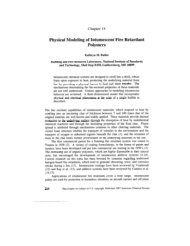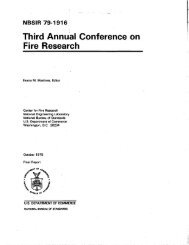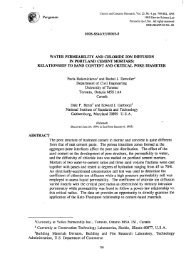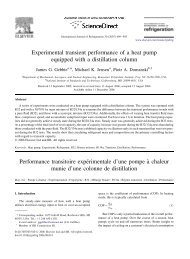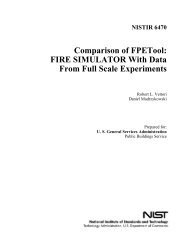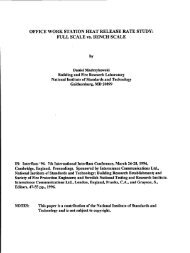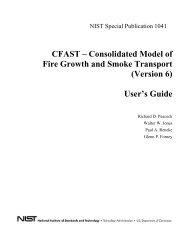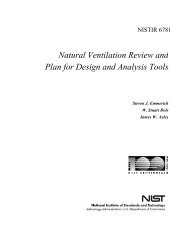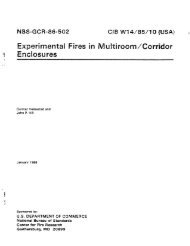Study of Technology for Detecting Pre-Ignition Conditions of ... - NIST
Study of Technology for Detecting Pre-Ignition Conditions of ... - NIST
Study of Technology for Detecting Pre-Ignition Conditions of ... - NIST
Create successful ePaper yourself
Turn your PDF publications into a flip-book with our unique Google optimized e-Paper software.
“.<br />
CPSC-IAG95-1145<br />
primary effect <strong>of</strong> range type was the amount <strong>of</strong> time required to bring food to ignition. Although<br />
sugar very quickly ignited on the gas range, oil and bacon needed about-50 ‘/0 more time to reach<br />
ignition conditions on the gas range compared to that needed on the electric range. Sugar<br />
required about 50 ‘/0 less time to ignite on the gas range than it required on the electric range,<br />
but the reason <strong>for</strong> this is explained in Section 3.7.2. While the gas burner flame is at a higher<br />
temperature than the electric element, the heat transfer rate to a pan is less <strong>for</strong> this particular gas<br />
range compared to this electric range. One reason <strong>for</strong> this is that the flame contact area on the<br />
pan is less than the open-coil element contact with the same pan.<br />
The measurements <strong>of</strong> velocity and temperature in the plume are higher at earlier stages<br />
<strong>for</strong> the gas range because <strong>of</strong> the instantaneous manner <strong>of</strong> burner ignition compared to the gradual<br />
temperature rise <strong>of</strong> an electric element. The burner post-flame gases themselves contribute to<br />
heating <strong>of</strong> the area above the burner more than the natural convection from an electric element.<br />
3.7.2 Food Type<br />
Oil and bacon require several minutes to reach boiling, and then smoking, conditions. The<br />
bacon fat must first liquify, as well, be<strong>for</strong>e boiling can begin, yet the lesser mass <strong>of</strong> liquid<br />
produced by the bacon compared to the oii requires less time to heat, vaporize, and produce<br />
smoke. Sugar requires less time than bacon and oil to begin generating smoke, and the<br />
production <strong>of</strong> smoke is more abrupt and less gradual than that <strong>of</strong> the other foods. Sugar and<br />
bacon seem to produce darker smoke than oil. Sugar has a unique behavior in that it melts,<br />
resolidifies, and then continues to pyrolyze as an intumescent (bubbling and swelling) char.<br />
A reason <strong>for</strong> sugar’s faster ignition behavior on the gas range as compared to the electric<br />
range is related to the ring-shaped gas flame and the failure <strong>of</strong> the heat to spread across the entire<br />
sugar mass equally. As liquids, oil and grease tended to conduct and convect heat more readily<br />
than sugar, and they equalized the temperature distribution. Sugar retained the heat unevenly in<br />
the local area above the burner flame which allowed the lesser amount <strong>of</strong> sugar to progress to<br />
ignition in less time than all <strong>of</strong> the sugar would have required. The aluminum clad bottom <strong>of</strong><br />
the pan was not completely successfi.d in distributing the heat evenly. It is possible that the test<br />
<strong>of</strong> sugar on the gas range with the range hood on faiied to ignite because the remaining sugar<br />
acted as a heat sink and a barrier to plume generation which prevented the local area <strong>of</strong> sugar<br />
trans<strong>for</strong>mation from developing enough flammable vapor and high temperature.<br />
3.7.3 Range-Hood Status<br />
The range-hood capacity seemed to be overwhelmed by the plume behavior <strong>of</strong> the heated<br />
foods. When smoke generation was at steady, high levels, most <strong>of</strong> the smoke seemed to bypass<br />
the range hood. The largest hood available in our survey had about 75 YO greater flow capacity<br />
than the hood used, but it is likely that such an increase would only partially alleviate the<br />
accumulation <strong>of</strong> smoke. The high-output gas-range test on sugar with the range hood active did<br />
not produce ignition conditions, while sugar cooked on the same range with the hood inactive did<br />
ignite. It is not known whether the hood played a significant role in this case, if the explanation<br />
57



